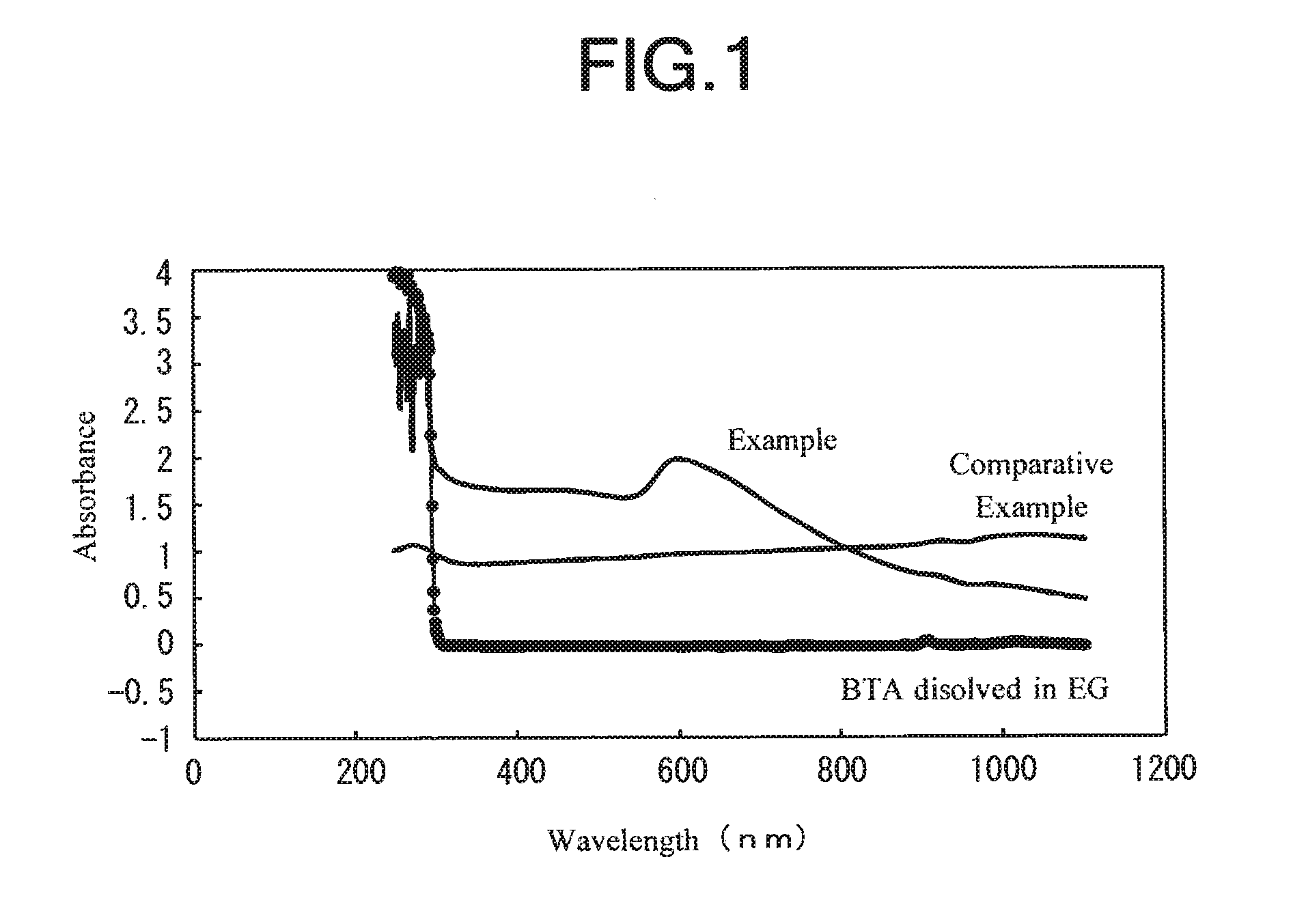Copper particle dispersing solution and method for producing conductive film using same
a technology of copper particle and solution, applied in the direction of conductive pattern formation, electrically conductive paints, transportation and packaging, etc., can solve the problems of complex process, inability to fire the paste, inability to form patterns on a substrate, etc., and achieve good storage stability and good electrical conductivity
- Summary
- Abstract
- Description
- Claims
- Application Information
AI Technical Summary
Benefits of technology
Problems solved by technology
Method used
Image
Examples
example 1
[0020]First, there were prepared 280 g of copper sulfate pentahydrate serving as a copper source, 1 g of benzotriazole (BTA) serving as a dispersing agent, a solution A obtained by dissolving 1 g of a water-based antifrothing agent (ANTIFLOTH F244 commercially available from DKS Co., Ltd.) in 1330 g of water, a solution B obtained by allowing 200 g of an aqueous solution containing 50% by weight of sodium hydroxide serving as a neutralizer to be diluted with 900 g of water, and a solution C obtained by allowing 150 g of an aqueous solution containing 80% by weight of hydrazine monohydrate as a reducing agent to be diluted with 1300 g of water.
[0021]Then, the solution A and the solution B were mixed with each other while being stirred, and the temperature of the mixed solution was adjusted to 60° C. Thereafter, while maintaining the stirring, all of the solution C was added to the mixed solution within 30 seconds. After about 5 minutes, the reaction was completed to produce a slurry....
example 2
[0034]A copper particle dispersing solution (conductive filler: 67% by weight) was obtained by the same method as that in Example 1, except that the ratio of the weight of the fine copper particles coated with BTA to the weight of the flake-shaped copper particles was 5:5.
[0035]This copper particle dispersing solution was used for producing a conductive film by flexographic printing by the same method as that in Example 1. Then, the electrical resistance (line resistance) of the conductive film was measured by the same method as that in Example 1, and the volume resistivity thereof was obtained by the same method as that in Example 1. As a result, when the thickness of the conductive film was μm, the electrical resistance (line resistance) thereof was 1.5Ω, and the volume resistivity thereof was 11 μΩ·cm. When the thickness of the conductive film was 4 μm, the electrical resistance (line resistance) thereof was 1.2Ω, and the volume resistivity thereof was 17 μΩ·cm. When the thicknes...
example [UNK]
Example 3˜5
[0037]Copper particle dispersing solutions (conductive filler: 67% by weight) were obtained by the same method as that in Example 1, except that spherical copper particles having an average particle diameter of 0.5 μm were used in place of the flake-shaped copper particles and that the ratio of the weight of the fine copper particles coated with BTA to the weight of the spherical copper particles was 1:9 (Example 3), 3:7 (Example 4) and 5:5 (Example 5), respectively.
[0038]These copper particle dispersing solutions were used for producing conductive films by flexographic printing by the same method as that in Example 1. Then, the electrical resistance (line resistance) of each of the conductive films was measured by the same method as that in Example 1, and the volume resistivity thereof was obtained by the same method as that in Example 1. As a result, with respect to the conductive film obtained by using the copper particle dispersing solution in Example 3, when the thic...
PUM
| Property | Measurement | Unit |
|---|---|---|
| particle diameter | aaaaa | aaaaa |
| particle diameter | aaaaa | aaaaa |
| pulse voltage | aaaaa | aaaaa |
Abstract
Description
Claims
Application Information
 Login to View More
Login to View More - R&D
- Intellectual Property
- Life Sciences
- Materials
- Tech Scout
- Unparalleled Data Quality
- Higher Quality Content
- 60% Fewer Hallucinations
Browse by: Latest US Patents, China's latest patents, Technical Efficacy Thesaurus, Application Domain, Technology Topic, Popular Technical Reports.
© 2025 PatSnap. All rights reserved.Legal|Privacy policy|Modern Slavery Act Transparency Statement|Sitemap|About US| Contact US: help@patsnap.com

